One of the more dramatic mountain airstrips we fly to from Timika, Tsinga is certainly very photogenic and probably what a lot of people will think of when someone mentions “mountain airstrips”. Perched on a ridge at 6500 ft, it looks simply stunning with steep sloping sides dropping off rapidly to the valley floor below. In reality, it’s actually not as tricky or dangerous to land on compared to many other far less dramatic looking airstrips.
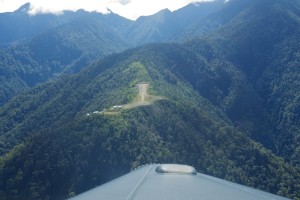 |
| Final approach into Tsinga/Mulu airstrip, Papua |
Runway statistics
Orientation: 28/10 (Landing 20, take-off 10)
Length: 560m
Elevation: 6500ft
Slope: 1% up until last 50m, then 15%
Surface: hard clay with moss growing through in places
CAUTION: Slippery when wet. Moss growing on outer edges is always slippery.
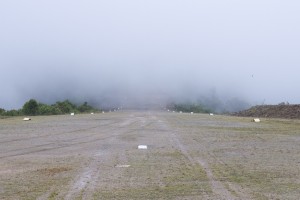 |
| Clouds rolling over the airstrip in Tsinga/Mulu, Papua |
Pilot notes
Tsinga is located about 10nm south and slightly east of Puncak Jaya mountain, on the southern side of the main mountain ranges running east-west along the Papua province. It’s built on a ridge inside a larger natural bowl, surrounded by higher terrain. The villages it serve are located in the valley below which is quite a hike from the airstrip (about 1-2 hours I’m told).
Once you take away the fact it’s located on a ridge and look at the raw statistics, you realise Tsinga is actually a very nicely constructed, straight, smooth airstrip with plenty of length to land a Porter on. The airstrip was constructed by PT Freeport Indonesia, who own the large copper and gold mine located just to the west of Puncak Jaya mountain, to help with local development for the surrounding villages.
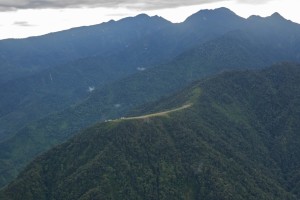 |
| Tsinga/Mulu airstrip, Papua |
As far as landing goes, I tend to approach from the south as the bowl is much more open here. This is effectively like joining a right base for runway 28, at 7500ft. The surrounding terrain can throw one’s perspective out a little but provided one maintains a good steep approach, there shouldn’t be any issues. Go-arounds are possible right up until touchdown by turning out to the right.
Departures are also straightforward with plenty of length allowing a standard rolling take-off. The extra slope at the eastern end of the airstrip can be utilised but is unnecessary unless the clouds are causing problems seeing the entire length of the airstrip.
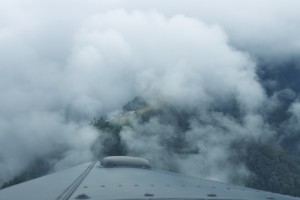 |
| Tsigna/Mulu approach in cloudy weather |
And speaking of clouds, that’s one of the main weather hazards we get in Tsinga. They tend to start building from 10am onwards, so it’s always advisable to get there nice an early. Even if there are clouds covering the airstrip, they tend to come and go very quickly with the steady winds that blow at this altitude. It’s not uncommon to suddenly loose visual with the airstrip on short finals which requires a turn away to the right back into the bowl to another attempt.
Along with the clouds there’s also adiabatic winds which can make the approach somewhat turbulent. Again, landing early in the day negates this problem.
I really enjoy operating into Tsinga. It’s dramatic location never ceases to make me grin when I’m coming in on approach. It’s also handily close to Timika being only 15 minutes away, and as most of the fun in bush flying is the landings and take-offs, I especially like the very short cruise elements of these flights.
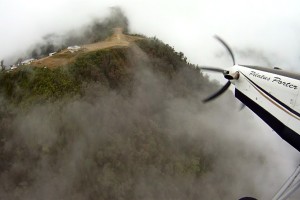 |
| GoPro approach into a cloudy Tsinga/Mulu airstrip, Papua |
Everything written in this article are opinions of the author and should not be taken as sole reference for attempting a flight into or out of the aforementioned airstrip.
Discover more from Matt Dearden
Subscribe to get the latest posts sent to your email.

Hello,
I have a question! Why they don’t use helicopters if cruise times are low? Pilatus takes 2 tones helicopter can take 20t and airstrip is not needed. Altitude? If the flights are sponsored by government anyway so the price is not an issue?
Andrius
They do use helicopters! PT Freeport charters PT AirFast to fulfil their requirement there to various locations on the southern side of the mountains including the Tsinga area. We simple provide a government subsidised bi-weekly schedule between Timika and Tsinga for passengers and cargo.
The Porter can take around 900kgs on this flight. As for 20 tonnes, that must be a mighty big helicopter! The biggest they have currently is the Mil Mi-8 Hevilift helicopter which carries around 3 tonnes, usually as 24 passengers.
Oh and price is ALWAYS an issue, regardless of who’s paying!
Hi Matt,
could you inform me whats the schedule flight Timika – Tsinga, what days, I read somewhere 2 times a week.
Thanks
I’m not really sure as I don’t fly from Timika any more. I think two times a week is probably correct though.